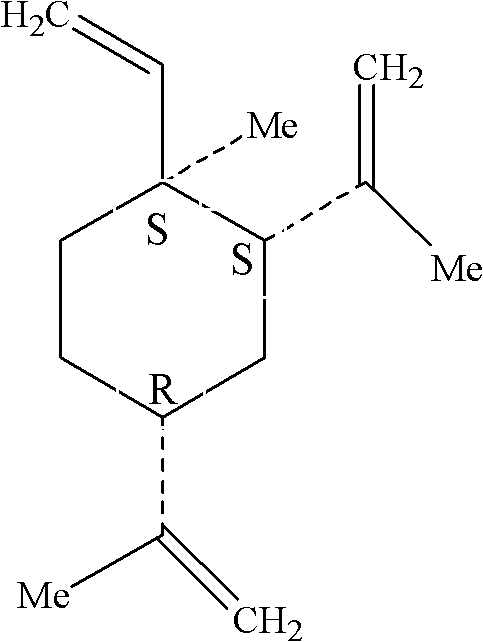Method for extracting and separating beta-elemene from Lantana camara
A technology of elemene and lantana, which is applied in the field of extraction and separation of β-elemene, can solve the problems of high price, high cost of extraction and purification, hindering popularization and application, and achieve the effect of an effective method
- Summary
- Abstract
- Description
- Claims
- Application Information
AI Technical Summary
Problems solved by technology
Method used
Image
Examples
Embodiment 1
[0066] Example 1 Extraction and separation of β-elemene from lantana by distillation
[0067] A. Raw material preparation: collect lantana stems and leaves, dry them naturally in the sun, crush them, and pass through a 40-mesh sieve.
[0068] B. Extraction of volatile oil: Get 100g of the raw material obtained in step A, put it into a distillation bottle, add 500mL of deionized water or distilled water, 200mL of ethylene glycol, 50mL of ethanol, 3-5 zeolites, heat and distill at normal pressure, and collect 80 Distillate at -150°C. Petroleum ether (boiling range 30-60° C.) was added to the obtained distillate at a ratio of 1:1, and the extraction was repeated three times. The petroleum ether layers were separated and combined, and the solvent was vacuum-dried at 60° C. to obtain a volatile oil (purity > 20%).
[0069] C, HPLC preparation: the volatile oil obtained in step B is separated with the following HPLC system: Shimadzu HPLC-10A, C18 preparation column (10mm * 150mm),...
Embodiment 2
[0070] Example 2 Extraction and separation of β-elemene from lantana by distillation
[0071] A. Raw material preparation: collect lantana stems and leaves, dry them naturally in the sun, crush them, and pass through a 40-mesh sieve.
[0072] B. Extraction of volatile oil: Take 100g of the raw material obtained in step A, put it into a distillation bottle, add 500mL of deionized water or distilled water, 200mL of ethylene glycol, 50mL of ethanol, 3-5 zeolites, heat and distill at normal pressure, and collect 80 Distillate at -150°C. Petroleum ether (boiling range 30-60° C.) was added to the obtained distillate at a ratio of 1:1, and the extraction was repeated three times. The petroleum ether layers were separated and combined, and the solvent was vacuum-dried at 60° C. to obtain a volatile oil (purity > 30%).
[0073] C, HPLC preparation: the volatile oil obtained in step B is separated with the following HPLC system: Shimadzu HPLC-10A, C18 preparation column (10mm * 150mm)...
Embodiment 3
[0074] Example 3 Extraction and separation of β-elemene from lantana by distillation
[0075] A. Raw material preparation: collect lantana stems and leaves, and grind them into pulp with a pulverizer.
[0076] B. Extraction of volatile oil: Take 100g of the raw material obtained in step A, put it into a distillation bottle, add 500mL of deionized water or distilled water, 200mL of ethylene glycol, 50mL of ethanol, 3-5 zeolites, heat and distill at normal pressure, and collect 80 Distillate at -150°C. In the obtained distillate, benzene was added in a ratio of 1:1, and the extraction was repeated three times. The petroleum ether layers were separated and combined, and the solvent was vacuum-dried at 60° C. to obtain a volatile oil (purity > 30%).
[0077]C. Column chromatography: put the volatile oil obtained in step B on a 300mL HP20 macroporous resin chromatography column, and carry out successively with 600mL of distilled water, 80% ethanol, 85% ethanol, 90% ethanol, 95% e...
PUM
| Property | Measurement | Unit |
|---|---|---|
| boiling point | aaaaa | aaaaa |
Abstract
Description
Claims
Application Information
 Login to View More
Login to View More - R&D
- Intellectual Property
- Life Sciences
- Materials
- Tech Scout
- Unparalleled Data Quality
- Higher Quality Content
- 60% Fewer Hallucinations
Browse by: Latest US Patents, China's latest patents, Technical Efficacy Thesaurus, Application Domain, Technology Topic, Popular Technical Reports.
© 2025 PatSnap. All rights reserved.Legal|Privacy policy|Modern Slavery Act Transparency Statement|Sitemap|About US| Contact US: help@patsnap.com

